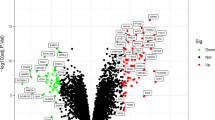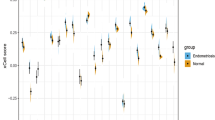Abstract
Endometriosis (EM) is a chronic, estrogen-dependent inflammatory disease. Presently, the pathophysiology of EM is still unclear, and numerous studies have established that the immune system plays a major role in the pathophysiology of EM. Six microarray datasets were downloaded from the GEO public database. A total of 151 endometrial samples (72 ectopic endometria and 79 controls) were included in this study. CIBERSORT and ssGSEA were applied to calculate the immune infiltration of EM and control samples. Moreover, we validated four different correlation analyses to explore immune microenvironment of EM and finally identified M2 macrophage-related hub genes and further conducted the specific immunologic signaling pathway analysis by GSEA. The logistic regression model was investigated by ROC and further validated by two external datasets. From the results of the two immune infiltration assays, we concluded that M2 macrophages, regulatory T cells (Tregs), M1 macrophages, activated B cells, T follicular helper cells, activated dendritic cells, and resting NK cells have a significant difference between control and EM tissues. Through multidimensional correlation analysis, we found that macrophages play an important central role in cell-to-cell interactions, especially M2 macrophages. Four immune-related hub genes, namely FN1, CCL2, ESR1, and OCLN, are closely related to M2 macrophages and play a crucial role in the occurrence and immune microenvironment of endometriosis. The combined AUC of ROC prediction model in test and validation sets were 0.9815 and 0.8206, respectively. We conclude that M2 macrophages play a central role in the immune-infiltrating microenvironment of EM.







Similar content being viewed by others
Data Availability
This study’s six GEO datasets (GSE7305, GSE23339, GSE11691, GSE25628, GSE37837, and GSE120103 datasets) were obtained from the GEO database (https://www.ncbi.nlm.nih.gov/geo/). Immune-related genes (IRGs) were obtained from the Immunology Database and Analysis Portal (ImmPort) (https://immport.org).
Code Availability
All code used during the study are available from the corresponding author by request.
References
Zannoni L, Forno SD, Paradisi R, Seracchioli R. Endometriosis in adolescence: practical rules for an earlier diagnosis. Pediatr Ann. 2016;45:e332–5.
Rolla E. Endometriosis: advances and controversies in classification, pathogenesis, diagnosis, and treatment. F1000Res. 2019;8
Wu B, Yang Z, Tobe RG, Wang Y. Medical therapy for preventing recurrent endometriosis after conservative surgery: a cost-effectiveness analysis. BJOG. 2018;125:469–77.
Bakhtiarizadeh MR, Hosseinpour B, Shahhoseini M, Korte A, Gifani P. Weighted gene co-expression network analysis of endometriosis and identification of functional modules associated with its main hallmarks. Front Genet. 2018;9:453.
Zondervan KT, Becker CM, Koga K, Missmer SA, Taylor RN, Vigano P. Endometriosis. Nat Rev Dis Primers. 2018;4:9.
Vallve-Juanico J, Houshdaran S, Giudice LC. The endometrial immune environment of women with endometriosis. Hum Reprod Update. 2019;25:564–91.
Hogg C, Horne AW, Greaves E. Endometriosis-associated macrophages: origin, phenotype, and function. Front Endocrinol (Lausanne). 2020;11:7.
Laskin DL, Sunil VR, Gardner CR, Laskin JD. Macrophages and tissue injury: agents of defense or destruction? Annu Rev Pharmacol Toxicol. 2011;51:267–88.
Chen P, Bonaldo P. Role of macrophage polarization in tumor angiogenesis and vessel normalization: implications for new anticancer therapies. Int Rev Cell Mol Biol. 2013;301:1–35.
Chen B, Khodadoust MS, Liu CL, Newman AM, Alizadeh AA. Profiling tumor infiltrating immune cells with CIBERSORT. Methods Mol Biol. 2018;1711:243–59.
Ye L, Zhang T, Kang Z, Guo G, Sun Y, Lin K, Huang Q, Shi X, Ni Z, Ding N, Zhao KN, Chang W, Wang J, Lin F, Xue X. Tumor-infiltrating immune cells act as a marker for prognosis in colorectal cancer. Front Immunol. 2019;10:2368.
Hanzelmann S, Castelo R, Guinney J. GSVA: gene set variation analysis for microarray and RNA-seq data. BMC Bioinformatics. 2013;14:7.
Davis S, Meltzer PS. GEOquery: a bridge between the Gene Expression Omnibus (GEO) and BioConductor. Bioinformatics. 2007;23:1846–7.
Hever A, Roth RB, Hevezi P, Marin ME, Acosta JA, Acosta H, Rojas J, Herrera R, Grigoriadis D, White E, Conlon PJ, Maki RA, Zlotnik A. Human endometriosis is associated with plasma cells and overexpression of B lymphocyte stimulator. Proc Natl Acad Sci U S A. 2007;104:12451–6.
Hull ML, Escareno CR, Godsland JM, Doig JR, Johnson CM, Phillips SC, Smith SK, Tavare S, Print CG, Charnock-Jones DS. Endometrial-peritoneal interactions during endometriotic lesion establishment. Am J Pathol. 2008;173:700–15.
Hawkins SM, Creighton CJ, Han DY, Zariff A, Anderson ML, Gunaratne PH, Matzuk MM. Functional microRNA involved in endometriosis. Mol Endocrinol. 2011;25:821–32.
Khan MA, Sengupta J, Mittal S, Ghosh D. Genome-wide expressions in autologous eutopic and ectopic endometrium of fertile women with endometriosis. Reprod Biol Endocrinol. 2012;10:84.
Crispi S, Piccolo MT, D'Avino A, Donizetti A, Viceconte R, Spyrou M, Calogero RA, Baldi A, Signorile PG. Transcriptional profiling of endometriosis tissues identifies genes related to organogenesis defects. J Cell Physiol. 2013;228:1927–34.
Bhat MA, Sharma JB, Roy KK, Sengupta J, Ghosh D. Genomic evidence of Y chromosome microchimerism in the endometrium during endometriosis and in cases of infertility. Reprod Biol Endocrinol. 2019;17:22.
Ritchie ME, Phipson B, Wu D, Hu Y, Law CW, Shi W, Smyth GK. limma powers differential expression analyses for RNA-sequencing and microarray studies. Nucleic Acids Res. 2015;43:e47.
Bhattacharya S, Dunn P, Thomas CG, Smith B, Schaefer H, Chen J, Hu Z, Zalocusky KA, Shankar RD, Shen-Orr SS, Thomson E, Wiser J, Butte AJ. ImmPort, toward repurposing of open access immunological assay data for translational and clinical research. Sci Data. 2018;5:180015.
Wang J, Vasaikar S, Shi Z, Greer M, Zhang B. WebGestalt 2017: A more comprehensive, powerful, flexible and interactive gene set enrichment analysis toolkit, Nucleic Acids Res. 2017;45:W130-W137.
Shannon P, Markiel A, Ozier O, Baliga NS, Wang JT, Ramage D, Amin N, Schwikowski B, Ideker T. Cytoscape: a software environment for integrated models of biomolecular interaction networks. Genome Res. 2003;13:2498–504.
Newman AM, Liu CL, Green MR, Gentles AJ, Feng W, Xu Y, Hoang CD, Diehn M, Alizadeh AA. Robust enumeration of cell subsets from tissue expression profiles. Nat Methods. 2015;12:453–7.
Ru B, Wong CN, Tong Y, Zhong JY, Zhong SSW, Wu WC, Chu KC, Wong CY, Lau CY, Chen I, Chan NW, Zhang J. TISIDB: an integrated repository portal for tumor-immune system interactions. Bioinformatics. 2019;35:4200–2.
Hudson QJ, Ashjaei K, Perricos A, Kuessel L, Husslein H, Wenzl R, Yotova I. Endometriosis patients show an increased M2 response in the peritoneal CD14(+low)/CD68(+low) macrophage subpopulation coupled with an increase in the T-helper 2 and T-regulatory cells. Reprod Sci. 2020;27:1920–31.
Vallve-Juanico J, Santamaria X, Vo KC, Houshdaran S, Giudice LC. Macrophages display proinflammatory phenotypes in the eutopic endometrium of women with endometriosis with relevance to an infectious etiology of the disease. Fertil Steril. 2019;112:1118–28.
Huang Y, Li Q, Hu R, Li R, Yang Y. Five immune-related genes as diagnostic markers for endometriosis and their correlation with immune infiltration. Front Endocrinol (Lausanne). 2022;13:1011742.
Zhong Q, Yang F, Chen X, Li J, Zhong C, Chen S. Patterns of immune infiltration in endometriosis and their relationship to r-AFS stages. Front Genet. 2021;12:631715.
Akoum A, Kong J, Metz C, Beaumont MC. Spontaneous and stimulated secretion of monocyte chemotactic protein-1 and macrophage migration inhibitory factor by peritoneal macrophages in women with and without endometriosis. Fertil Steril. 2002;77:989–94.
Ono Y, Yoshino O, Hiraoka T, Akiyama I, Sato E, Ito M, Kobayashi M, Nakashima A, Wada S, Onda T, Unno N, Osuga Y. IL-33 exacerbates endometriotic lesions via polarizing peritoneal macrophages to M2 subtype. Reprod Sci. 2020;27:869–76.
Bacci M, Capobianco A, Monno A, Cottone L, Di Puppo F, Camisa B, Mariani M, Brignole C, Ponzoni M, Ferrari S, Panina-Bordignon P, Manfredi AA, Rovere-Querini P. Macrophages are alternatively activated in patients with endometriosis and required for growth and vascularization of lesions in a mouse model of disease. Am J Pathol. 2009;175:547–56.
Capobianco A, Rovere-Querini P. Endometriosis, a disease of the macrophage. Front Immunol. 2013;4
Lagana AS, Salmeri FM, Ban Frangez H, Ghezzi F, Vrtacnik-Bokal E, Granese R. Evaluation of M1 and M2 macrophages in ovarian endometriomas from women affected by endometriosis at different stages of the disease. Gynecol Endocrinol. 2020;36:441–4.
Jensen AL, Collins J, Shipman EP, Wira CR, Guyre PM, Pioli PA. A subset of human uterine endometrial macrophages is alternatively activated. Am J Reprod Immunol. 2012;68:374–86.
Ramírez-Pavez TN, Martínez-Esparza M, Ruiz-Alcaraz AJ, Marín-Sánchez P, Machado-Linde F, García-Peñarrubia P. The role of peritoneal macrophages in endometriosis. Int J Mol Sci. 2021;22
Rostagno A, Williams MJ, Baron M, Campbell ID, Gold LI. Further characterization of the NH2-terminal fibrin-binding site on fibronectin. J Biol Chem. 1994;269:31938–45.
Matalliotaki C, Matalliotakis M, Rahmioglu N, Mavromatidis G, Matalliotakis I, Koumantakis G, Zondervan K, Spandidos DA, Goulielmos GN, Zervou MI. Role of FN1 and GREB1 gene polymorphisms in endometriosis. Mol Med Rep. 2019;20:111–6.
Yoshimura T. The chemokine MCP-1 (CCL2) in the host interaction with cancer: a foe or ally? Cell Mol Immunol. 2018;15:335–45.
Gou Y, Li X, Li P, Zhang H, Xu T, Wang H, Wang B, Ma X, Jiang X, Zhang Z. Estrogen receptor beta upregulates CCL2 via NF-kappaB signaling in endometriotic stromal cells and recruits macrophages to promote the pathogenesis of endometriosis. Hum Reprod. 2019;34:646–58.
Fini ME, Jeong S, Wilson MR. Therapeutic potential of the molecular chaperone and matrix metalloproteinase inhibitor clusterin for dry eye. Int J Mol Sci. 2020;22
Acknowledgements
We appreciate the unrestricted use of the GEO databases.
Funding
This work was supported by the National Key Research and Development Program of Ningbo (grant number 202003N4289) and Medical Health Science and Technology Project of Zhejiang Provincial Health Commission (grant number 2021440659). This work was supported by the Science and Technology Programs of Ningbo (grant no. 202003N4289) and the Medical and Health Science and Technology Program of Zhejiang Province, China (grant no. 2021440659).
Author information
Authors and Affiliations
Contributions
Tianhong Zhu, Yongming Du, and Yutao Guan contributed to conception and design. Tianhong Zhu and Bohong Jin carried out the analysis. Tianhong Zhu and Yutao Guan wrote the paper. Tianhong Zhu and Fubin Zhang collected and processed the data. Yutao Guan reviewed and edited the manuscript. All authors read and approved the final manuscript.
Corresponding author
Ethics declarations
Ethics Approval
This study is conducted based on the GEO database and is not involved in animal or human experiments. The patients involved in the database have obtained ethical approval. Users can download relevant data for free for research and publish relevant articles. Our study is based on open source data, so there are no ethical issues in this study.
Conflict of Interest
The authors declare no competing interests.
Additional information
Publisher’s Note
Springer Nature remains neutral with regard to jurisdictional claims in published maps and institutional affiliations.
Supplementary Information
ESM 1:
Supplementary Table 1 Validating the expression of 10 hub genes with GSE120103.
Rights and permissions
Springer Nature or its licensor (e.g. a society or other partner) holds exclusive rights to this article under a publishing agreement with the author(s) or other rightsholder(s); author self-archiving of the accepted manuscript version of this article is solely governed by the terms of such publishing agreement and applicable law.
About this article
Cite this article
Zhu, T., Du, Y., Jin, B. et al. Identifying Immune Cell Infiltration and Hub Genes Related to M2 Macrophages in Endometriosis by Bioinformatics Analysis. Reprod. Sci. 30, 3388–3399 (2023). https://doi.org/10.1007/s43032-023-01227-7
Received:
Accepted:
Published:
Issue Date:
DOI: https://doi.org/10.1007/s43032-023-01227-7




